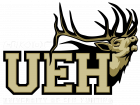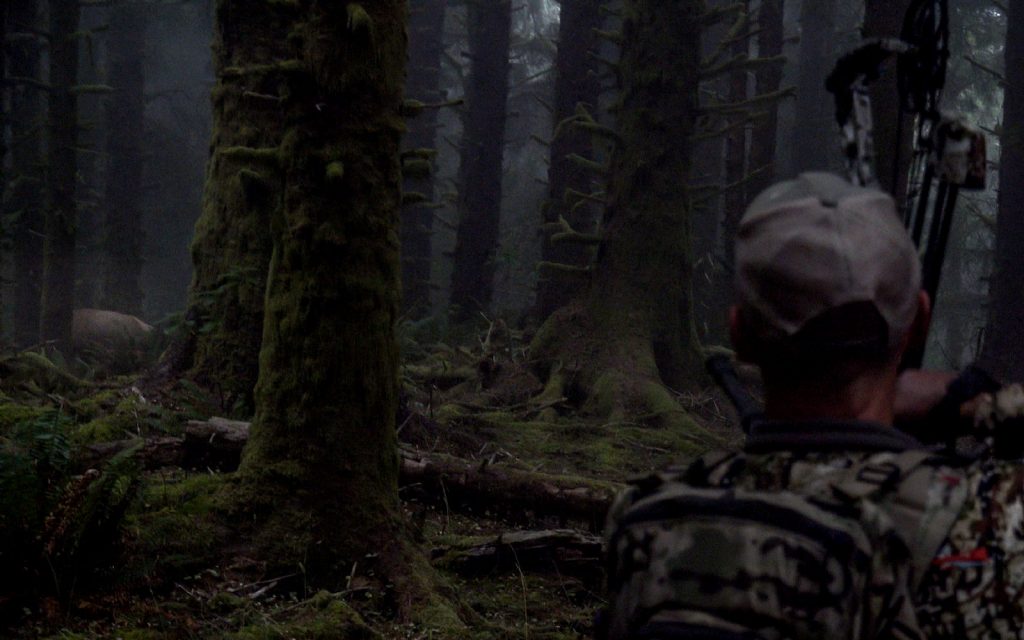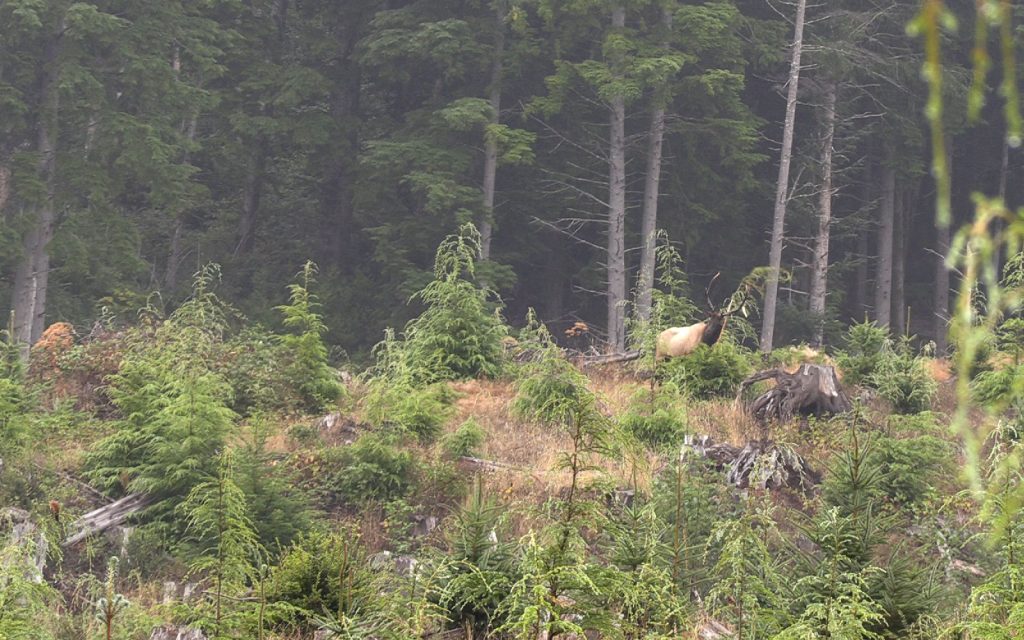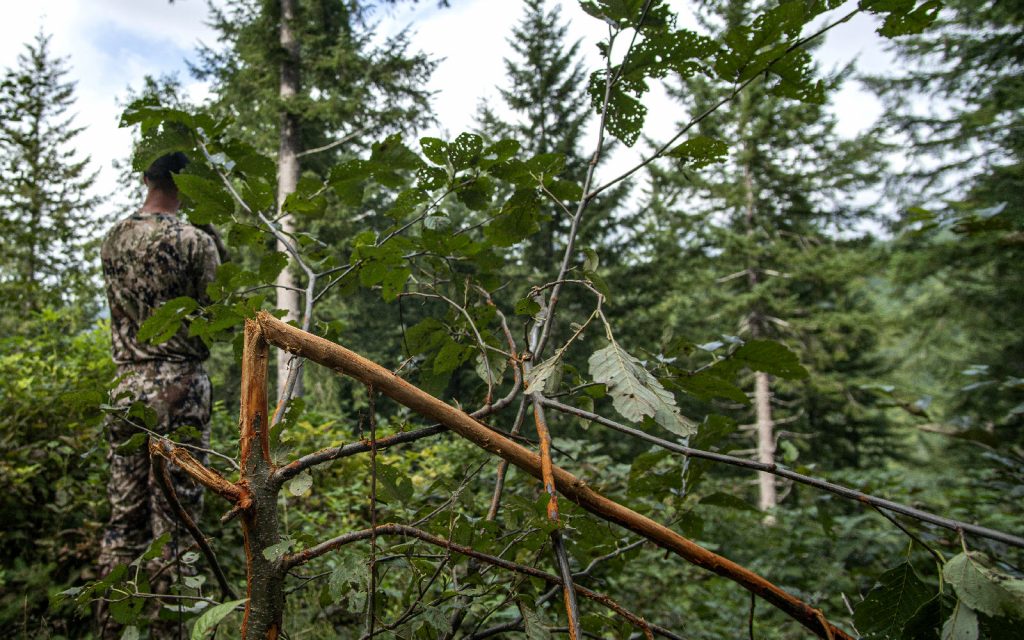
MODULE 16 - HUNTING ROOSEVELT ELK
CHAPTER 3: TACTICS FOR HUNTING ROOSEVELT ELK

When it comes right down to it, Roosevelt Elk are elk, and they behave much like any other elk. They eat, they bed down throughout the day, they rut, etc. Once you are able to navigate the challenges of the thick country they live in, and keeping a few of the nuances in mind pertaining to sound travel, thermals, and finding the elk, the tactics for hunting and calling in Roosevelt Elk really aren’t that much different from what you would use for Rocky Mountain Elk.
EARLY SEASON (PRE-RUT)
Many Roosevelt archery seasons open in late-August, before the rut really fires up. During this pre-rut/early season, calling is going to be less effective. This is a lesson I learned first-hand. We hunted for Roosevelt Elk in Oregon on my first trip, and because of our calendar and other hunts, we hunted late August through September 5th. The calling really didn’t start up until our last night of that hunt. I’ll talk a lot more about calling in the next section, but calling can make hunting Roosevelt Elk much easier for a couple of reasons.
If you are going to be hunting before calling gets good, you might want to focus on water sources and travel routes. However, keep in mind that there is water everywhere and Roosevelt Elk don’t usually travel very far. If you are able to find a good water source, wallow, or travel route, treestands can be effective. The real advantage of hunting from a treestand in Roosevelt country is achieving better visibility from an elevated perch. Roosevelt elk are somewhat patternable this time of year, which helps for both water holes and travel routes. Don’t completely write off calling as an effective tactic during this period, but I would certainly urge against relying on it. After September 5th or so, they will begin being more vocal, and calling will become more of an advantage for you.
THE RUT
Hands down, calling is going to be the most effective way to find and hunt Roosevelt elk in the thick habitat where many of them live. You’ll hear locals and old-timers talk about how Roosevelt elk don’t call much, and that they are impossible to call in. That’s not the case. Sure, there will be some bulls that don’t bugle much, and others that will be tough to call in, just like with Rocky Mountain Elk or any other species that communicates by calling. However, I think this stigma comes from the terrain, not necessarily from the vocal habits of the Elk.
As I mentioned before, the thick vegetation dampers sound, so while Roosevelt elk might be calling just as much a Rocky Mountain Elk, it’s going to be much harder to hear them most of the time. Your location bugles won’t carry as far, and might be met with silence 90% of the time. This just means you are going to have to cover more ground and be closer to the elk before you actually get a response. It definitely doesn’t mean the Roosevelt elk aren’t willing to talk.

And when it comes to actually using calls to call them in, I would say that Roosevelt elk are actually more susceptible to being called in, and often more aggressive. Because they live in such confined spaces, they are more territorial and less tolerant of a competitor moving into their area. Some bulls will become very vocal and agitated at your presence, and the standard calling sequence of a cow call followed by challenge bugle (see the Module on Calling Elk) can be very effective. However, not all Roosevelt bulls will be as vocal, even those who are keen on protecting their territory.
Often times, these bulls will be equally as aggressive, but will walk in to your calls quietly – or at least without bugling. You’ll need to be constantly listening for any indication that a bull is “sneaking” in on you – twigs snapping, branches breaking, brush rustling, etc. It’s amazing how these large, white-bodied beasts can simply materialize from out of nowhere. But as frustrating as it can be, there is nothing like looking up and seeing one of those white bodies all of a sudden standing where just seconds before there was nothing but coastal fog.
During the rut, the bulls will continue to use wallows, even though it seems like everything there is cool and wet. We were able to see multiple trail camera pictures of bulls on wallows while we were there, and finding an active wallow and placing a treestand there could definitely be very effective during this phase of the season as well.
More about locating bulls during the rut in just a minute…
POST-RUT
When it comes to post-rut hunting, good luck! Seriously, if you think hunting Roosevelt Elk with bow and arrow is a challenge, take a look at the success rates of the firearm seasons! These seasons are generally very short, and the elk grow wise very quickly. Without calling to aid you, and with the elk typically retreating to the thickest of areas, slipping along in the thick brush and hoping to see an elk – and then get a shot – can be a game of frustrations. Additionally, many elk will head for private land where they are not only protected by the thick vegetation, but also by private fences.
Finding logging areas (cuts) where the elk still feel safe to feed – often on timber company land or far away from accessible roads – can be effective for spotting the elk as they leave the logged areas at first light, or as they come out into the areas just before dark.
PROVEN TACTICS
BE “MORE” AGGRESSIVE
One of the most valuable lessons I learned from hunting with Shannon Mobbs in 2019 was to take my normal aggressive approach to pushing in on elk, and double it! I know….I was a bit timid to increase my already aggressive style of hunting as well!
However, once Shannon convinced me to step outside my comfort zone, I was able to prove him right on multiple occasions. When it comes to hunting Roosevelt elk in super thick terrain during the rut, you have to CREATE opportunities. Most time, opportunities don’t just happen. It is very common for a Roosevelt bull to come partway through a massive wall of brush, and then stop. If you watched Episode 7 of the 2019 Destination Elk V2 video series, this is exactly what happened. Fortunately, Shannon convinced us to just knock an arrow and start walking right through the brush at the elk. I really didn’t think it would work, but it did. We walked to within 7-8 yards of the bull as he stood there and held his ground. Unfortunately, even at 7-8 yards, it was so thick we never did see him. But even when he busted out and ran, he only went 25 yards, and we resumed the game of cat and mouse in the brush.
It is important that when you are walking aggressively at the bull in the thick brush that you be ready to shoot at very close distances.
Here is the Episode with the video of that encounter:
DEAL WITH THE RAIN
If you hunt Roosevelt elk on the west side of the Cascade Mountain range, and you hunt them for more than 3-4 days, you will experience rain. But the elk are used to the rain, and for the most part, they carry on with their daily activities.
However, rather than staying in the thick brush, when it’s raining hard, the elk will often move out into the open. Almost every day that we hunted in the rain, we found elk in clear cuts. Coming from the Rocky Mountains, that seemed odd to me. My first instinct when it starts raining hard is to head to the thick timber and hunker down under a big tree. But there are a couple reasons why elk find it better to be in the open when it’s raining hard in Roosevelt elk country
First, those thick canopies and brush tangles get really loud when it’s raining. The rain constantly hitting the leaves, and the water dripping off the trees onto the leaves is loud. To the point where you can’t hear bugles, you can’t hear branches breaking, etc. And since elk rely on their hearing to protect them, they don’t feel safe in the thick brush during a heavy rain.

Secondly, as hard as it may be to imagine, you will get more wet – by far – in the brush thickets than you will standing out in the wide open in an absolute downpour. So, the elk move out into the wide open where they can hear better, where they can see better, and where they are more comfortable. And we found that they will often stay out in the open much of the day during a heavy rain.
THE #1 PIECE OF ROOSEVELT ELK HUNTING ADVICE
In 2 seasons of hunting Roosevelt Elk, I feel like I have learned a ton and been able to put together a pretty solid game plan for achieving success. Thanks to knowledge shared from friends like Jody Cyr, as well as sharing time hunting elk in the field with guys like David Brinker, Brent Erikson, and Shannon Mobbs and Cory Ford, I have absolutely been given a first-hand crash course on some of the subtle differences – as well as some of the unique tactics – that consistently work for Roosevelt Elk.
But if I had to pick and share one nugget of Roosevelt Elk hunting gold that is the difference maker, it would be this: Learn to find, read, and use rubs.
When it comes to hunting Rocky Mountain Elk, I absolutely know the value of rubs (again, see the section on reading elk sign for more details on rubs and hunting Rocky Mountain Elk). And, in my first 14 days of Roosevelt Elk hunting experience, I used that knowledge in a similar manner. However, on my very first day hunting Roosevelt Elk with Shannon Mobbs, I gained insight that instantly made me a much better Roosevelt Elk hunter.
Shannon has an iPad mounted to the dash of his little hunting vehicle. I was intrigued by this simple tactic alone, but as he started showing me how he used the iPad to dial in his hunting strategy, it was enlightening, to say the least.
Shannon has one App loaded on his iPad – the “Hunt App” from OnXMaps. And he uses it similar to how most elk hunters use it – he navigates roads, land ownership, and terrain. He also adds waypoints of where he finds elk year after year. This database of knowledge is vital to being able to go back season after season and find pockets of elk. None of this was new to me.
He also adds waypoints of where he finds rubs. Again, nothing new – I do the same thing. However, when it comes to Roosevelt Elk hunting, it turns out that these rubs shown as waypoints on his OnX Hunt App are gold.
On our first morning, Shannon opened his OnX Hunt app and showed me the area we would be hunting. He had 8-10 rubs marked as waypoints, and at first glance, there was nothing special about these waypoints. But as he began explaining the significance of these rubs and how they guide him straight to the elk, the lightbulb came on for me.

Similar to whitetail deer and their “scrape lines”, Roosevelt Elk have “rub lines”. And while a couple fresh rubs along the side of the road might only tell you that an elk has been “right there” recently, as you mark more and more rubs along the road and along the ridges you hike, you can actually see a very clear picture of where that specific bull is travelling and spending his time. And he will continue to use that travel route frequently during the rut.
As you connect multiple rubs in the same area, and then use OnX to identify a vantage point (or points), it will allow you to broadcast a location bugle efficiently into the bull’s territory.
With multiple rubs identified, locating a bugling bull in this tangled maze of dense vegetation often becomes much, much easier. I saw it work day after day while hunting with Shannon.
We would analyze rubs that he had marked on his Hunt app, and often be able to clearly identify a ridge system or mountainside a bull elk was using as his “range”. Then, we would find a ridgetop or knob that would provide access for our bugles to carry into this area, and head there. We received responses to our location bugles with greater than 50% success using this tactic.
Now, rather than spending precious time fighting brush just “hoping” to get a response and locate a bull, we were able to locate bulls every single morning we hunted – often in the first area we tried – and then spend our precious time fighting the brush and steep terrain to work in toward the bull that we got the response from.
Here is a short video of Shannon explaining in his own words how he uses rubs to precisely locate and pinpoint Roosevelt bulls during the rut:
CONCLUSION
While there are differences between how you hunt for Roosevelt Elk and Rocky Mountain Elk, the differences are often just a matter of geography and terrain more than actual differences in characteristics of the species.
The jungle-like coastal haunts where Roosevelt Elk call home bring a myriad of challenges, mostly unfamiliar to a Rocky Mountain Elk hunter. However, with patience, perseverance, and a good set of pruning shears, Roosevelt Elk hunting will grow on you. And through the enchantments of the moss-covered old-growth rainforest, you’ll likely hear the faint, muffled bugle of a Roosevelt Elk responding to your calls – and calling you back year after year!
Click "Next Module" Below to Continue to the next Module on "Hunting Cow Elk".




